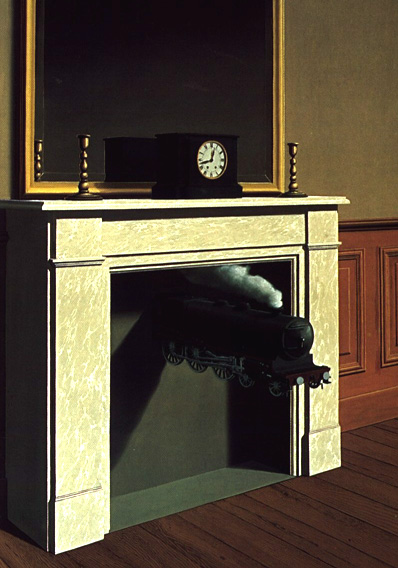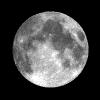


| Technology as definitive. | ||
| What is time? | ||
| Does technology shape our experience, or our conceptualization of time? | ||
 |
||
 |
 |
|
| The phases of the moon define our months. | ||
Sun Dials consist of a style rising perpendicular to the base plate where different numbers are etched. The style was called a gnomon by the Greeks and Romans. This gnomon when exposed to the sun casts a shadow and where the shadow falls across the plate indicates more than just the hour of the day.
Gnomon
 Babylonians,
Egyptians and Greeks all kept track of time through the use of sun dials.
Babylonians,
Egyptians and Greeks all kept track of time through the use of sun dials.
The Greeks later developed a timing device to measure the duration of speeches by filling a basin with water and releasing that amount of water through a small hole at the base of the bowl.
Literally, gnomon, referred to the instrument that casts a shadow, thereby measuring the "time of day."
Figuratively speaking, the root word: gnomon, is the derivation of gnosis or knowledge, from which the words, diagnosis and prognosis come. The ancient Christian sect called "Gnostics" who authored gospels believed that God was best understood, or knowable through the pursuit of knowledge about the world that had been created by the divine presence working in the material universe. Condemned as heretics, the Gnostics were persecuted in the middle ages.
 Literally speaking a chronometer is any sort of device that can
track the interval separating two points in time, or a duration between one
distinguishable event from another separate event. Cronus, is the name of the
Titan (precursor of the Olympian Gods in ancient Greece) who was the father
of Zeus (Jupiter) and his siblings: Hades (Pluto), Poseidon (Neptune), and other
gods and goddesses. His association with the passage of time and his later Roman relation to the planet Saturn (easily observed in the night sky) derive from a first century Greek source that described Knossos in Crete as the dwelling place of Cronus, his wife Rhea and the titans.
Literally speaking a chronometer is any sort of device that can
track the interval separating two points in time, or a duration between one
distinguishable event from another separate event. Cronus, is the name of the
Titan (precursor of the Olympian Gods in ancient Greece) who was the father
of Zeus (Jupiter) and his siblings: Hades (Pluto), Poseidon (Neptune), and other
gods and goddesses. His association with the passage of time and his later Roman relation to the planet Saturn (easily observed in the night sky) derive from a first century Greek source that described Knossos in Crete as the dwelling place of Cronus, his wife Rhea and the titans.
From the time of the Sumerians and Egyptians, celestial bodies were associated with the gods, and the planets particularly could be watched in order to track the passage of time between phases of the moon (every 28 days) and the diurnal movement of the sun through the daylight hours and the stars through the evening hours.
Clepsydra, the name of the Egyptian and Greek instrument to indicate the passage of time, or duration between the start and finish of an event. The device was a clay or stone bowl and by filling a bowl with water and allowing the content to drain away at a steady speed.
Clock, the mechanical instrument that changed Medieval life.
The city clock in Prague dates from the high middle ages and tracks both the time of the day, month and seasons. In addition it has automatons that move about the clock's face on the hour to entertain the public.
Clocks became common in Europe in the period after 1310 about a generation before the bubonic plague struck Europe. In 1092, however, Su Sung built an enormous water driven mechanical clock to predict the movement of the heavens. His water wheel, drive shaft and escapement mechanisms are still considered the finest mechanical achievement of its day.
The path of the timepiece from China to Europe was neither direct nor quick. Only after the introduction from Baghdad and the Islamic east of an even older Chinese device which was a mechanically designed and water operated instrument that recorded the movement of heavenly bodies in the course of a day, a week, a month or a season during the course of a year.
This clock tower in Prague dates form 1410.
Concepts
Time should be associated with the duration, frequency and elapsed period between similar or contrasting experiences.
"During the first two decades of the twentieth century, Albert Einstein made two deep discoveries. Each caused a radical upheaval in our understanding of space and time. Einstein dismantled the rigid, absolute structures that Newton had erected, and built his own tower, synthesizing space and time in a manner that was completely unanticipated. When he was done, time had become so enmeshed with space that the reality of one could no longer be pondered separately from the other."
Brian Green, The Fabric of the Cosmos, (2004), page 39.
Conclusions
Time may be thought of as a representative number, but "the non spatial continuum" that we say (the number represents) defines time, has become a symbolically significant concept. This conception of time is actually the complex product of technological innovation from the invention of calculation to the building of machinery and the construction of automatic devices to produce materials, track production, or measure the effectiveness of different techniques (ways of making things).
Yes, time is shaped by our technology in so far as we conceptualize time as something we tell, or mark or even measure.
By that we mean:
- Can you tell what time it is?
- The passing of time is marked by the seasons.
- Seconds, minutes, hours are measures of time passing.
Duration is measured and referred to as "time passing" because technology in the form of analog and digital clocks has deepened our understanding of how old and how recent certain natural conditions are, such as the age of the earth and stars, or the birth of a child or the sprouting of seeds.
Figuratively speaking, "time" has become fundamental to technology in two related but specifically different ways:
Return to Pursell | duration as dimension | Technology | Start of web site | Terms used | Move-on to Postman
Technology index ![]() landscape index
landscape index ![]() words index
words index ![]() photograph index
photograph index